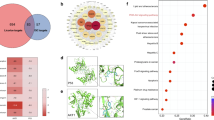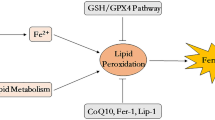Abstract
Neuronal apoptosis mediated by the mitochondrial apoptosis pathway is an important pathological process in cerebral ischemia–reperfusion injury. 14,15-EET, an intermediate metabolite of arachidonic acid, can promote cell survival during ischemia/reperfusion. However, whether the mitochondrial apoptotic pathway is involved this survival mechanism is not fully understood. In this study, we observed that infarct size in ischemia–reperfusion injury was reduced in sEH gene knockout mice. In addition, Caspase 3 activation, cytochrome C release and AIF nuclear translocation were also inhibited. In this study, 14,15-EET pretreatment reduced neuronal apoptosis in the oxygen–glucose deprivation and re-oxygenation group in vitro. The mitochondrial apoptosis pathway was also inhibited, as evidenced by AIF translocation from the mitochondria to nucleus and the reduction in the expressions of cleaved-caspase 3 and cytochrome C in the cytoplasm. 14,15-EET could reduce neuronal apoptosis through upregulation of the ratio of Bcl-2 (anti-apoptotic protein) to Bax (apoptosis protein) and inhibition of Bax aggregation onto mitochondria. PI3K/AKT pathway is also probably involved in the reduction of neuronal apoptosis by EET. Our study suggests that 14,15-EET could suppress neuronal apoptosis and reduce infarct volume through the mitochondrial apoptotic pathway. Furthermore, the PI3K/AKT pathway also appears to be involved in the neuroprotection against ischemia–reperfusion by 14,15-EET.




Similar content being viewed by others
Abbreviations
- 14,15-EET:
-
14,15-Epoxyeicosatrienoic acid
- OGD/R:
-
Oxygen–glucose deprivation and reoxygenation
- sEH:
-
Soluble epoxide hydrolase
- AIF:
-
Apoptosis-inducing factor
- MCAO:
-
Middle cerebral artery occlusion
- CREB:
-
cAMP response element-binding protein
- LDH:
-
Lactate dehydrogenase
- Smac:
-
Second mitochondrial activator of caspases
References
Kristen AV, Ackermann K, Buss S, Lehmann L, Schnabel PA, Haunstetter A, Katus HA, Hardt SE (2013) Inhibition of apoptosis by the intrinsic but not the extrinsic apoptotic pathway in myocardial ischemia-reperfusion. Cardiovasc Pathol 22(4):280–286
Al-Jamal KT, Gherardini L, Bardi G, Nunes A, Guo C, Bussy C, Herrero MA, Bianco A, Prato M, Kostarelos K, Pizzorusso T (2011) Functional motor recovery from brain ischemic insult by carbon nanotube-mediated siRNA silencing. Proc Natl Acad Sci USA 108(27):10952–10957
Akpan N, Serrano-Saiz E, Zacharia BE, Otten ML, Ducruet AF, Snipas SJ, Liu W, Velloza J, Cohen G, Sosunov SA, Frey WH, Salvesen GS, Connolly ES Jr, Troy CM (2011) Intranasal delivery of caspase-9 inhibitor reduces caspase-6-dependent axon/neuron loss and improves neurological function after stroke. J Neurosci 31(24):8894–8904
Thal SE, Zhu C, Thal SC, Blomgren K, Plesnila N (2011) Role of apoptosis inducing factor (AIF) for hippocampal neuronal cell death following global cerebral ischemia inmice. Neurosci Lett 499(1):1–3
Sun Y, Zhang Y, Wang X, Blomgren K, Zhu C (2012) Apoptosis-inducing factor downregulation increased neuronal progenitor, but not stem cell, survival in the neonatal hippocampus after cerebral hypoxia-ischemia. Mol Neurodegener 7:17
Koerner IP, Jacks R, DeBarber AE, Koop D, Mao P, Grant DF, Alkayed NJ (2007) Polymorphisms in the human soluble epoxide hydrolase gene EPHX2 linked to neuronal survival after ischemicinjury. J Neurosci 27(17):4642–4649
Li R, Xu X, Chen C, Yu X, Edin ML, Degraff LM, Lee CR, Zeldin DC, Wang DW (2012) Cytochrome P450 2J2 is protective against global cerebral ischemia in transgenic mice. Prostaglandins Other Lipid Mediat 99(3–4):68–78
Simpkins AN, Rudic RD, Schreihofer DA, Roy S, Manhiani M, Tsai HJ, Hammock BD, Imig JD (2009) Soluble epoxide inhibition is protective against cerebral ischemia via vascular and neural protection. Am J Pathol 174(6):2086–2095
Zhang W, Otsuka T, Sugo N, Ardeshiri A, Alhadid YK, Iliff JJ, DeBarber AE, Koop DR, Alkayed NJ (2008) Soluble epoxide hydrolase gene deletion is protective against experimental cerebral ischemia. Stroke 39(7):2073–2078
Dorrance AM, Rupp N, Pollock DM, Newman JW, Hammock BD, Imig JD (2005) An epoxide hydrolase inhibitor, 12- (3-adamantan-1-yl-ureido)dodecanoic acid (AUDA), reduces ischemic cerebral infarct size in stroke-prone spontaneously hypertensive rats. J Cardiovasc Pharmacol 46(6):842–848
Sarkar P, Narayanan J, Harder DR (2011) Differential effect of amyloid β on the cytochrome P450 epoxygenase activity in rat brain. Neuroscience 194:241–249
Gross GJ, Gauthier KM, Moore J, Campbell WB, Falck JR, Nithipatikom K (2009) Evidence for role of epoxyeicosatrienoic acids in mediating ischemic preconditioning and postconditioning in dog. Am J Physiol Heart Circ Physiol 297(1):H47–H52
Dhanasekaran A, Gruenloh SK, Buonaccorsi JN, Zhang R, Gross GJ, Falck JR, Patel PK, Jacobs ER, Medhora M (2008) Multiple antiapoptotic targets of the PI3K/Akt survival pathway are activated by epoxyeicosatrienoic acids to protect cardiomyocytes from hypoxia/anoxia. Am J Physiol Heart Circ Physiol 294(2):H724–H735
Lin FS, Shen SQ, Chen ZB, Yan RC (2012) 17β-estradiol attenuates reduced-size hepatic ischemia/reperfusion injury by inhibition apoptosis via mitochondrial pathway in rats Shock 37(2):183–190
Wang HX, Zhang DM, Zeng XJ, Mu J, Yang H, Lu LQ, Zhang LK (2012) Upregulation of cytochrome P450 2J3/11,12-epoxyeicosatrienoic acid inhibits apoptosis in neonatal rat cardiomyocytes by a caspase-dependent pathway. Cytokine 60(2):360–368
Ma J, Zhang L, Li S, Liu S, Ma C, Li W, Falck JR, Manthati VL, Reddy DS, Medhora M, Jacobs ER, Zhu D (2010) 8,9-Epoxyeicosatrienoic acid analog protects pulmonary artery smooth muscle cells from apoptosis via ROCK pathway. Exp Cell Res 316(14):2340–2353
Liu Y, Wan Y, Fang Y, Yao E, Xu S, Ning Q, Zhang G, Wang W, Huang X, Xie M (2016) Epoxyeicosanoid signaling provides multi-target protective effects on neurovascular unit in rats after focal ischemia. J Mol Neurosci 58(2):254–265
Wang L, Chen M, Yuan L, Xiang Y, Zheng R, Zhu S (2014) 14,15-EET promotes mitochondrial biogenesis and protects cortical neurons against oxygen/glucose deprivation-induced apoptosis. Biochem Biophys Res Commun 450(1):604–609
Liu P, Lin Y, Tang X, Zhang P, Liu B, Liu Y, Miao F (2016) Helix B surface peptide protects cardiomyocytes against hypoxia/reoxygenation-induced apoptosis through mitochondrial pathways. J Cardiovasc Pharmacol 67(5):418–426
Kaneko Y, Shojo H, Burns J, Staples M, Tajiri N, Borlongan CV (2014) DJ-1 ameliorates ischemic cell death in vitro possibly via mitochondrial pathway. Neurobiol Dis 62:56–61
Peixoto PM, Lue JK, Ryu SY, Wroble BN, Sible JC, Kinnally KW (2011) Mitochondrial apoptosis-induced channel (MAC) function triggers a Bax/Bak-dependent bystander effect. Am J Pathol 178(1):48–54
Cabon L, Galán-Malo P, Bouharrour A, Delavallée L, Brunelle-Navas MN, Lorenzo HK, Gross A, Susin SA (2012) BID regulates AIF-mediated caspase-independent necroptosis by promoting BAX activation. Cell Death Differ 19(2):245–256
Czabotar PE, Lessene G, Strasser A, Adams JM (2014) Control of apoptosis by the BCL-2 protein family: implications for physiology and therapy. Nat Rev Mol Cell Biol 15(1):49–63
Nair V, Pathi S, Jutooru, Sreevalsan S, Basha R, Abdelrahim M, Samudio I, Safe S (2013) Metformin inhibits pancreatic cancer cell and tumor growth and downregulates Sp transcription factors. Carcinogenesis 34(12):2870–2879
Yuan Z, Syed MA, Panchal D, Joo M, Colonna M, Brantly ML, Sadikot RT (2014) TREM-1 mediated Bcl-2 induction prolongs macrophage survival. J Biol Chem 289(21):15118–15129
Shi GX, Cai W, Andres DA (2012) Rit-mediated stress resistance involves a p38-mitogen- and stress-activated protein kinase 1 (MSK1)-dependent cAMP response element-binding protein (CREB) activation cascade. J Biol Chem 287(47):39859–39868
Sacerdoti D, Pesce P, Di Pascoli M, Bolognesi M (2016) EETs and HO-1 cross-talk. Prostaglandins Other Lipid Mediat 125:65–79
Liu X, Qian ZY, Xie F, Fan W, Nelson JW, Xiao X, Kaul S, Barnes AP, Alkayed NJ (2016) Functional screening for G protein-coupled receptor targets of 14,15-epoxyeicosatrienoic acid. Prostaglandins Other Lipid Mediat. doi: 10.1016/j.prostaglandins.2016.09.002
Dou MY, Wu H, Zhu HJ, Jin SY, Zhang Y, He SF (2016) Remifentanil preconditioning protects rat cardiomyocytes against hypoxia-reoxygenation injury via δ-opioid receptor mediated activation of PI3K/Akt and ERK pathways. Eur J Pharmacol 789:395–401
Zhang P, Guo ZF, Xu YM, Li YS, Song JG (2016) N-Butylphthalide (NBP) ameliorated cerebral ischemia reperfusion-induced brain injury via HGF-regulated TLR4/NF-κB signaling pathway. Biomed Pharmacother 83:658–666
Yuan L, Liu J, Dong R, Zhu J, Tao C, Zheng R, Zhu S (2016) 14,15-Epoxyeicosatrienoic acid promotes production of BDNF from astrocytes and exerts neuroprotective effects during ischemic injury. Neuropathol Appl Neurobiol 42(7):607–620
Qiu B, Hu S, Liu L, Chen M, Wang L, Zeng X, Zhu S (2013) CART attenuates endoplasmic reticulum stress response induced by cerebral ischemia and reperfusion through upregulating BDNF synthesis and secretion. Biochem Biophys Res Commun 436(4):655–659
Sun L, Zhao M, Yu XJ, Wang H, He X, Liu JK, Zang WJ (2013) Cardioprotection by acetylcholine: a novel mechanism via mitochondrial biogenesis and function involving the PGC-1α pathway. J Cell Physiol 228(6):1238–1248
Acknowledgements
This work was supported by Henan Province Research Program of Basic and Advanced Technology (162300410102), Henan Postdoctoral Foundation (2015051) and Henan Province Foundation for University Key Teacher (15A180031, 16A330001).
Author information
Authors and Affiliations
Corresponding authors
Rights and permissions
About this article
Cite this article
Geng, HX., Li, RP., Li, YG. et al. 14,15-EET Suppresses Neuronal Apoptosis in Ischemia–Reperfusion Through the Mitochondrial Pathway. Neurochem Res 42, 2841–2849 (2017). https://doi.org/10.1007/s11064-017-2297-6
Received:
Revised:
Accepted:
Published:
Issue Date:
DOI: https://doi.org/10.1007/s11064-017-2297-6




